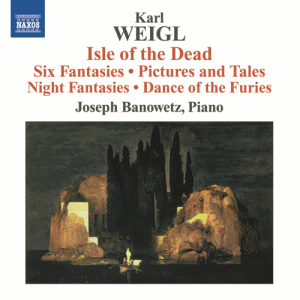 |
 |
|


alternatively
CD: MDT
AmazonUK
AmazonUS
Sound
Samples & Downloads |
Karl WEIGL (1881-1949)
Isle of the Dead (1903) [13.12]
Pictures and Tales, Op.2 (1909) [13.03]
Night Fantasies, Op.13 (1911) [21.35]
Dance of the Furies (1937-8) [5.21]
Six Fantasies (1942) [25.30]
 Joseph Banowetz (piano)
Joseph Banowetz (piano)
rec. Skywalker Sound, Marin County, California, 9-10 November, 18
December 2009
 NAXOS 8.572423 [78.49]
NAXOS 8.572423 [78.49]
|
|
|
Karl Weigl was yet another of the many European composers who
sought refuge in America during the Nazi era. He had begun his
career in Vienna as a pianist and as a conductor under Mahler,
but after a time started to focus on large-scale orchestral
canvases. He does not appear to have been happy in exile, and
was largely neglected as a composer, turning again to smaller-scale
pieces which had more chance of performance. However he wrote
two later symphonies (see review), and these have recently been recorded by the
Berlin Radio Symphony Orchestra under Thomas Sanderling for
BIS. The Fifth Symphony, subtitled Apocalyptic,
is a real surprise (see review) - it begins with the sound of the orchestra tuning up and only
gradually does the thematic material emerge from this early
example of ‘free music’. The two symphonies are
otherwise thoroughly romantic works, for all the world as if
the Second Viennese School had never existed.
His piano music, on the other hand, is far less ambitious. The
pieces here are all either early or late works, and seem to
have been intended largely for Weigl’s own performances
as a recitalist. The disc opens with the charming Six Fantasies
which he originally wrote for occasional recitals or broadcasts
in America but then it does not seem that any public performances
ever actually materialised. They are pretty lightweight trifles,
designed clearly as crowd-pleasers pure and simple. Nor are
they really virtuoso pieces; they could indeed have been written
a hundred years earlier, and would not have turned heads even
then. Only the final movement, subtitled Halloween, generates
any real sense of excitement; this piece makes more demands
on the pianist, which Banowetz handles with aplomb and a nice
lightness of touch.
Weigl appears to have been the first composer to have taken
inspiration from Böcklin’s famous painting of the
Totinsel, before either Reger (in his beautiful Four
Böcklin Pictures) or Rachmaninov in his large-scale
symphonic poem. However Weigl never published his score - he
seems to have regarded it as a piece of juvenilia - and
the performance here is claimed, amazingly enough, to be the
first one ever given. It is a nicely atmospheric piece reflecting
its subject, and shows no signs of immaturity. That said, it
is rather over-long for its content, and the limited tone-colour
of the piano cannot begin to compete with its orchestral rivals.
It ends very inconclusively - was this intentional, or did Weigl
simply leave the piece unfinished?
The six pieces which make up the Bilder und Geschichten
take their titles from various children’s rhymes and stories,
and have a certain kinship to Schumann’s Kinderszenen.
These are again very straightforward pieces, although they would
be too complex for most children to play. Even the movement
Sleeping Beauty’s grave is very lightweight, indeed
almost frisky. The Tanz der Erinnyen was written just
before Weigl left for America, and he afterwards seems to have
forgotten it because he never performed or published it; it
was not performed until 1970. It is quite a virtuoso piece,
and has the implication of a gesture of defiance to the inhospitable
Europe that he was leaving behind.
The Nachtphantasien on the other hand were taken up by
several pianists, although Weigl himself only ever performed
individual movements in a simplified version for two pianos.
Perhaps his technique was simply not up to it - which might
also explain the relatively modest demands made on the pianist
in the works that he did compose for his own recitals. These
are the best works on this disc, moody and reflective with a
nice line in stormy passion; the first movement contains a brief
passage (at 2.05) which anticipates the melody Prokofiev would
later use in his lament in Alexander Nevsky. The later
pieces are rather less impressive, reminiscent of Rachmaninov
but without the same sheer force of personality.
Listeners who wish to make the acquaintance of Weigl would be
served far better by listening to one of the recordings of the
symphonies as an initial introduction to the work of an unfairly
neglected composer. The piano pieces included here help to round
out our impressions of one of the last of the late romantics,
but they do not give a rounded picture of a composer whose inspiration
seems to have worked better on a larger scale. Banowetz however
should be congratulated on his continuing willingness to explore
the fringes of the repertory, and gives nicely intimate performances
in well-rounded sound. None of the music here over-taxes his
abilities, but it is nevertheless nice to make its acquaintance.
Paul Corfield Godfrey
|
|

